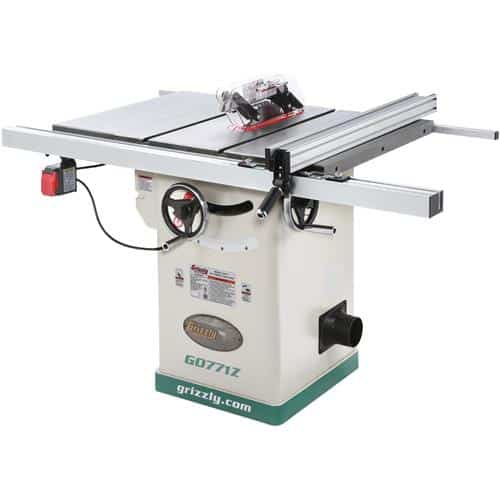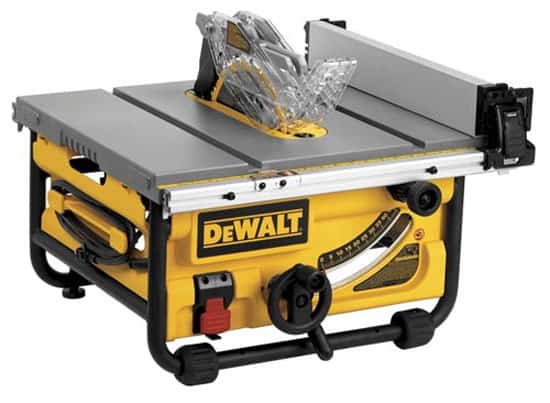What is a cabinet table saw?
A cabinet saw is a piece of cutting equipment enclosed and looks like a cabinet. Cabinet saws are capable of performing extremely fast cutting operations. Professionals who need to construct projects with various materials and cuts will find this cutting gadget to be highly useful and user-friendly.
Even though cabinet saws come with hefty materials like cast iron and steel, you may use them to deal with denser materials. The arbor’s design and the usage of a powerful motor aid decrease the amount of distracting vibration while working. Not only that, but a cabinet saw’s bearings and pulleys are all more durable than the others.

One of the most significant advantages of a cabinet saw is its portability. Because of its enclosed design, it is effortless to collect dust. Another benefit of utilizing a cabinet saw is that you can replace it fast and efficiently.
Cabinet saws have an easily removable insert around the blade in the tabletop that allows zero-clearance inserts to use, which reduces tear-out on the bottom of the workpiece significantly. A table extension that extends the ripping capability for sheet goods to 50 inches is usual on this type of saw (1.3 m).
A cast iron top on a full-length steel base, typically square in shape, with radiused corners, distinguishes these saws. Two 3/4-inch-wide (19 mm) miter slots are parallel to the blade, one to the left and one to the right of the blade (1 inch [25 mm] wide on the larger saws).
- It features a completely enclosed foundation.
- To improve precision and reduce vibration, it uses cast iron and steel extensively.
- Induction motors power it
- It has an easy-to-replace insert around the blade that allows zero-clearance inserts to be used.
- It has a thicker structure for increased durability and reduced vibration.
- It has a high duty-cycle capability.
- It comes with a table extender that boosts the ripping capacity to up to 50″.
What is a Contractor Saw?
Contractor saws are often lightweight (in the 250-350 lb. range) and reasonably priced for hobbyists and homeowners. In cost and portability, contractor saws make a few compromises. The extension wings may be built of open webbed cast iron or stamped metal, even though most contractor saws come with a solid cast iron tabletop. A contractor saw that trunnions, gears, and arbor assembly are less husky than those found on more expensive saws.

The contractor saw motor is usually attached to the arbor assembly via a single V-belt. It sways off the back of the saw – a feature initially intended to make the engine easier to detach for transport. up to 50.”
Contractor saws are still the most cost-effective option for the home shop, and they’re ideal for carpentry, modest cabinetry projects, trim work, and basic furniture construction. Many contractor saws now include high-quality fence systems as standard equipment.
What is the difference between a cabinet saw and a contractor saw?
- Cabinet saws are manufactured with more cast iron and steel, have heavier trunnions, gears, and arbour assemblies, and have more powerful motors than their contractor saw counterparts.
- Contractor saws have exposed motors, whereas cabinet saws have enclosed motors.
- Cabinet saw motors are often more potent than a contractor saw motors.
Similarities
- Both cabinet saws and contractor saws may help you efficiently manufacture various materials and products, but the methods by which they accomplish these aims can differ substantially depending on your experience level and other factors.
- Cabinet saws and Contractor saws are both capable of cutting vast pieces of material without sacrificing quality or precision, which is why skilled material crafters and building builders use them frequently.
Advantages and Disadvantages of a Cabinet Saw
- It produces precise cuts.
Using a ruler between the fence and the blade or between the bench side and the blade, you may double-check your measurements, allowing more accurate and error-free cuts.
- It’s adaptable.
Cabinet table saws can handle a wide range of tasks with simplicity and versatility.
- Cuts are simple, and there is little resistance.
Because there is a fence where wood may be pressed and directed, you can be sure of precise, straight, and easy cuts.
- Speed
The revolutions per minute are relatively high because of the circular saw and electric motor, resulting in quick and effective wood ripping.
Disadvantages
- For some cabinet table saw brands, dust gathers at the foot of the cabinet.
- It has a massive and heavyweight appearance.
- Some cabinet table saw models have lower horsepower, limiting the amount of woodcut.
- Some models of cabinet table saws lack levelling adjustments and must be balanced using wedges.
Advantages and Disadvantages of a Contractor Saw
Advantages
- Contractor saws are made for producing lengthy rip cuts and are suitable for working with huge, flat slabs of wood.
- Contractor’s saws are portable and easy to transport from job site to job site.
- If the motor has to be repaired or replaced, it is usually simple to get to.
- The saw is lighter and easier to set up with an open design base.
- When compared to cabinet saws, it is less expensive.
Disadvantages
- Dust collection is frequently difficult, if not impossible because the motor is attached to the back of the saw.
- Adjusting the fence might be a pain
- Some of the most challenging tasks that necessitate heavy-duty processing are beyond the scope of a contractor saw.
When should a contractor saw be used?
If you’re okay with less cutting power, more vibration, and more dust, a contractor table saw is the way to go. A contractor table saw is a beautiful alternative for the space-conscious, and their electric draw does not necessitate rewiring a circuit. Contractor saws are still the most cost-effective option for the home shop, and they’re ideal for carpentry, modest cabinetry projects, trim work, and basic furniture construction.
When should a cabinet saw be used?
Cabinet saws are ideal for and capable of handling extremely high duty cycles, such as those used in commercial and industrial applications. These saws have advanced to the point where they can perform efficient, high-volume, precise work.
Safety
Both are safe in terms of security. Saws are particularly hazardous since the operator holds the material being cut rather than the saw, making it simple to move hands into the spinning blade by accident. The material remains stationary while using other circular saws because the operator directs the saw into the material.
A push stick, riving knife, and protective cover over the spinning saw, on the other hand, can help to lessen the risk of an accident. Kickbacks are one of the most common problems.
When you rip a piece of wood, it either pinches the blade or twists outward against the blade of the rotating saw, propelling it back at high speed towards the operator. Kickback injuries are caused by wood impacting the operator’s head, chest, or torso or by the wood moving too quickly for the operator’s hands to stay on the wood and be pulled across the saw blade.
- Pyrography Techniques for Beginners: Textures and Shading - January 23, 2024
- Troubleshooting Jointer Issues: Why is Your Jointer Not Flattening Wood? - October 11, 2023
- Unlocking the Secrets of Jointing to Increase Width - September 29, 2023
